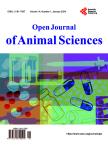Rearing Velocity Impacts on Landlocked Fall Chinook Salmon (<i>Oncorhynchus tshawytscha</i>) Growth, Condition, and Survival
Rearing Velocity Impacts on Landlocked Fall Chinook Salmon (<i>Oncorhynchus tshawytscha</i>) Growth, Condition, and Survival作者机构:South Dakota Department of Game Fish and Parks Spearfish McNenny State Fish Hatchery South Dakota USA
出 版 物:《Open Journal of Animal Sciences》 (动物科学期刊(英文))
年 卷 期:2014年第4卷第5期
页 面:244-252页
主 题:Chinook Salmon Oncorhynchus tshawytscha Velocity Circular Tanks
摘 要:Juvenile landlocked Chinook salmon (Oncorhynchus tshawytscha) (mean ± SD initial weight 2.6 ± 0.7 g, fork length 6.3 ± 0.5) were reared in three different water velocities [0.5, 1.5 and 3.0 body length/s (BL/s)] for four weeks to determine possible effects of water velocity on growth, condition, and survival. Fish were sampled for weight, fork length, condition factor, hepatosomatic index (HSI), viscerosomatic index (VSI), and fin erosion after four weeks of feeding to satiation. At the end of the feeding trial, the fish were handled and transported to simulate stocking, with survival observed over the following 10 d. Following four weeks of feeding, fish reared in 0.5 and 1.5 BL/s had the same growth and food conversion ratio, but fish reared at 3.0 BL/s had a significant reduction in both metrics. Furthermore, fish reared at 1.5 BL/s had a significantly higher condition factor than fish reared in other treatments. No significant differences were found for HSI, VSI, fin erosion, or survival. The results from this study indicate that a moderate velocity (1.5 BL/s), which is necessary for circular tanks to be self-cleaning, is not detrimental to fish growth or condition, but a faster water velocity (3.0 BL/s) negatively affects fish growth and food utilization.



